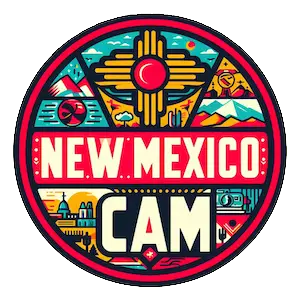Taos Ski Valley, NM Weather Cams
Lower Plaza Cam
Base Cam
Highline Cam
Kachina Basin Cam
Kachina Peak Cam
Poco Snow Stake Cam

Taos Plaza Cam
Arroyo Seco Cam
Taos Ski Valley: A Legendary Ski Destination Carved Into New Mexico’s Towering Peaks
Taos Ski Valley, NM Weather Cams. Nestled high in the Sangre de Cristo Mountains of northern New Mexico, Taos Ski Valley has been a beloved winter sports destination for over half a century. This legendary ski resort traces its origins back to the late 1950s when a young Swiss immigrant named Ernie Blake fell in love with the rugged terrain and ample snowfall of the area.
The Birth of a Ski Mecca (1920s-1940s)
The story of Taos Ski Valley began long before the construction of its first lift. In the early 20th century, Taos, a burgeoning art colony, attracted artists and writers seeking inspiration in the rugged beauty of the Southwest. Among them was Ernest Hemingway, who, in 1924, witnessed the first documented ski run in the area. This pioneering moment set the stage for a burgeoning ski culture, fueled by the adventurous spirit of the era.
The 1930s saw the establishment of the Taos Ski Club, a group of dedicated skiers who organized races and contributed to the development of the sport in the region. The club’s efforts were recognized in 1939 with the construction of the “Little Lift,” the first ski lift in Taos Ski Valley. This modest machine, powered by a car engine and a hand crank, offered a taste of the future, ushering in a new era of accessibility to the mountain’s pristine slopes.
A Family Legacy Takes Root (1950s-1970s)
The post-war era witnessed the rise of Taos Ski Valley as a true ski destination. In 1955, the resort was purchased by Ernie Blake, a ski enthusiast and visionary who saw its immense potential. Blake’s family, with a passion for the sport and a commitment to preserving the mountain’s natural beauty, established a legacy that would shape the valley for generations to come.
Under Blake’s leadership, Taos Ski Valley underwent a period of significant growth. The introduction of the first chairlift in 1956, followed by the construction of new lodges and the expansion of the ski area, solidified its place as a leading ski resort in the Southwest. Blake, known for his dedication to safety and his commitment to environmental responsibility, created a community spirit that resonated with both locals and visitors.
The 1960s and 1970s saw Taos Ski Valley become a popular destination for skiers seeking an authentic mountain experience. The resort’s reputation for challenging terrain, breathtaking scenery, and a laid-back atmosphere attracted a diverse crowd, including skiers, snowboarders, and families. This period also marked the emergence of Taos Ski Valley as a cultural hub, hosting artistic events and attracting a growing community of artists and musicians drawn to its unique character.
Transition and Expansion (1980s-2000s)
Following Ernie Blake’s passing in 1989, the resort transitioned into the hands of a new generation of leadership. The Blake family, guided by their father’s legacy, continued to invest in the resort’s development, ensuring its continued growth while staying true to its core values.
The 1990s saw the introduction of new technologies, including snowmaking capabilities and improved lift systems, enhancing the ski experience and extending the season. The construction of the Village at Taos Ski Valley, a charming pedestrian village featuring shops, restaurants, and accommodations, further enhanced the resort’s appeal, offering visitors a complete mountain experience.
The turn of the millennium marked a period of renewed emphasis on sustainability. The resort embraced eco-conscious practices, implementing initiatives to minimize its environmental impact and promote responsible tourism. These efforts, coupled with the dedication to preserving the mountain’s natural beauty, solidified Taos Ski Valley’s reputation as a leader in sustainable mountain resort management.
Navigating Challenges and Embracing the Future (2010s-Present)
The 2010s brought new challenges to Taos Ski Valley, as the global economic downturn and changing trends in the ski industry impacted the resort’s profitability. However, the Blake family, unwavering in their commitment to the valley’s future, navigated these challenges by focusing on strategic investments, diversification, and community partnerships.
The resort’s recent focus on developing its base area, including the construction of a new hotel, an expanded village center, and a state-of-the-art ski school, has revitalized the visitor experience. These investments, combined with a renewed commitment to sustainable practices, have positioned Taos Ski Valley for continued growth and success in the years to come.
Legacy and Significance
Taos Ski Valley’s story is not merely about skiing; it is a testament to the power of vision, perseverance, and community. From its humble beginnings as a pioneering ski destination to its evolution as a world-class resort, Taos Ski Valley has consistently celebrated the spirit of adventure, the beauty of the natural world, and the power of human connection.
The resort’s legacy extends far beyond the slopes. It has become a cultural touchstone, attracting artists, writers, musicians, and skiers who seek a unique and authentic mountain experience. Taos Ski Valley’s dedication to preserving its natural environment and its commitment to sustainable practices have set a benchmark for responsible tourism in the mountains.
As Taos Ski Valley continues to evolve and adapt to the changing landscape of the ski industry, one thing remains constant: its dedication to the mountains, its community, and the enduring spirit of adventure that has defined it for over a century. It stands as a vibrant reminder that the mountains offer not just a physical challenge but also a sanctuary for the soul, a place where we can reconnect with nature, ourselves, and each other.
For more information, visit the official Taos Ski Valley website.
